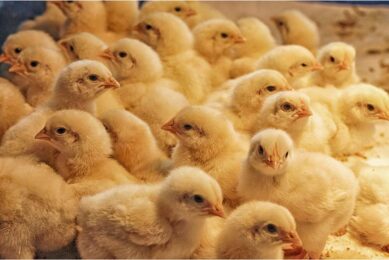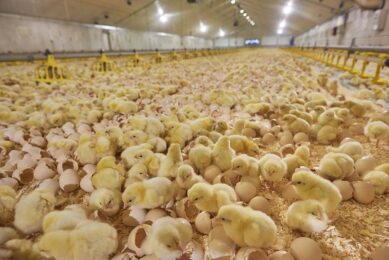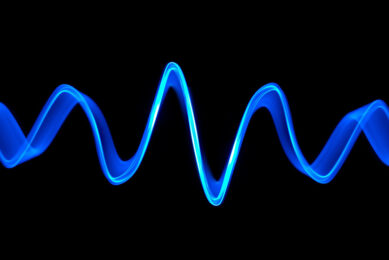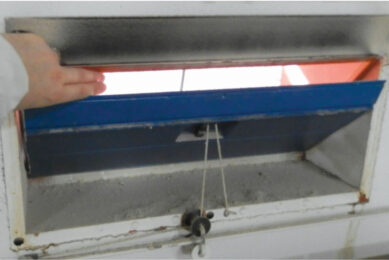Minimising fluff production in hatchers
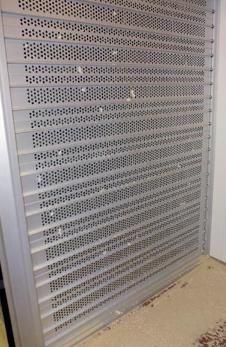
From an environmental standpoint, expelling fluff from hatcheries – more specifically from hatchers – is gaining much interest. A number of hatcheries are currently confronted with regulations concerning the amount of dust (or fluff) that can be introduced into the environment. HatchTech has developed the CyClean system to meet with this demand to minimise fluff.
By Dr Ron Meijerhof,HatchTech Incubation Technology, Veenendaal, the Netherlands
HatchTech’s R&D department measured the amount of fluff expelled from both the 28800 and 42240 model hatchers. In both machinesthe production of fluff is approx. 7.7 g per 1,000 hatched chicks. This is the amount of fluff that leaves the machine in the outgoing air. The real production of fluff is actually much higher, but the majority remains in the machines and in the take-off room. It does not leave the machine by the exhaust air.
Although chicks from HatchTech machines typically develop a large amount of fluff, they do not produce significantly more fluff than other machines. While the average air velocity in HatchTech hatchers is significant, the peak velocities are relatively low as the air velocity is very uniform at every spot in the machine. Traditional machines have a high air velocity around the stacks of hatcher baskets. This forces the fluff to stay airborne and in motion, which means that in other machines a larger percentage of the fluff produced is actually exhausted with the outgoing air.
Visual inspection of plenums shows that HatchTech hatchers do not exhaust more fluff into the plenum than other hatchers. This is despite the fact that the amount of fluff in the machines itself is in fact significantly increased.
Amount of air during hatching
While production of fluff begins shortly after the first chicks have hatched, the amount is negligible since there are relatively few chicks. Additionally, the chicks are still wet. Noticeable fluff production starts 3-6 hours after the first chick has hatched from the egg, during which time the typical ventilation volume is approx. 5m3 per hour for each 1,000 eggs/chicks. Over a period of approx. 12 hours the ventilation increases in a linear pattern to approx. 17m3per hour for each 1,000 chicks/eggs. The maximum ventilation is maintained for approx. 12 hours until the chicks are removed from the hatcher and the ventilation is reduced to zero (Figure 1).The total amount of ventilation for every 1,000 chicks during the hatching, or fluff production period, is:
12 hours x 11 m3 per hour = 132 m3 and 12 hours x 17 m3 per hour = 204 m3
| HatchTech developed CyClean, which expels a large amount of fluff from the air in incubators. |
The total amount of ventilation per 1,000 chicks during the hatching period is 336 m3. This means that approx. 350 m3 of a ir per 1,000 chicks hatched is necessary for ventilation of the hatcher in the period that fluff is produced. This figure will be more or less standard for each modern machine in the field, regardless of brand or type. At this ventil ation rate, the CO2 level will be approx. 3,000 – 4,000 ppm. Older machines that rely on air for cooling will ventilate substantially more.
With a ventilation rate of 350 m3, every 1,000 chicks produce 7.7 g of fluff in the hatch period. If no plenum or HatchTech CyCleanTM is used, there will be 0.022 g or 22 mg of fluff in each cubic meter of exhaust air.
Plenum and CyClean compared
The HatchTech R&D department measurements show that a plenum in an ideal situation captures approx. 50% of the fluff in the outgoing air. With a properly functioning plenum, there is 11 mg of fluff per cubic meter of exhaust air leaving the hatchery. The HatchTech R&D department measurements show that the CyClean in the hatcher reduces the amount of fluff in the exhaust air by at least 95% (Table). With the CyClean, the amount of fluff in the exhaust air of the hatchers is reduced to only 1 mg per m3 of exhaust air, 10 mg per m3 of exhaust air less than a properly functioning plenum.
In Figure 2 the amount of fluff in the exhaust air is given for a hatcher that has a capacity of 40,000 eggs. This figure illustrates that the total amount of fluff that this hatcher expels (in one hatching period) without plenum or CyClean is approx. 320 g, or 22 mg/m3 of exhaust air. When a plenum is used, the total amount of fluff is 152 g or 11 mg/m3 of exhaust air. A hatcher equipped with a CyClean will produce a total of 16 g fluff or 1 mg/m3 of exhaust air. These calculations are based on equal production of fluff over time. It also assumes that all of the exhaust air contains the same quantity of fluff. In reality, a peak production of fluff in certain periods can be expected.
For example, suppose the maximum allowed concentration of fluff in every m3of air is 5 mg/m3 of air. With the HatchTech CyClean, the maximum allowed exhaust concentration is not exceeded if the peak production of fluff at any given moment is five times higher than the average. The CyClean provides clean air in and around the hatchery, in combination with a significant space and cost reduction.




